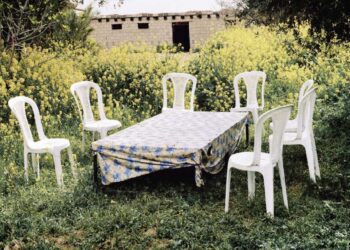It is a sunny and windy day in Aousja, a tiny Tunisian town famous for its Potato Festival in the governorate of Bizerte. Traveling along roads through vast stretches of farmland, we arrive at a rusted gate. Stepping through it, we meet Nizar Al-Hajam, a 39-year-old farmer who reaches us riding his motorcycle.
He explains to us that climatic shifts have caused severe drought problems. “That’s why I had to find a solution to ease the anxiety caused by the lack of rain,” Al-Hajam tells us. The solution he embraced was to plant carob trees, among the other crops cultivated on his land.
This hardy species, which has thrived in the Mediterranean for over 4,000 years, offers several advantages. One of them is its minimal water requirement for irrigation, as well as its extremely low dependency on agricultural inputs, such as fertilisers and pesticides, due to its natural resistance to diseases and pests. The carob tree takes 5 to 10 years to bear its fruit, a brown and curved pod. While this delay might seem like a disadvantage for farmers who must wait years before harvesting and selling the crop, Al-Hajam views it as a long-term investment. In fact, from his perspective, it will allow him to adapt to climate change and its related phenomena, like drought.
A possible solution
According to a 2023 report by the Food and Agriculture Organization of the United Nations (FAO), in 42 years of daily rainfall observations in the North of the country, 22 droughts were recorded. These events lasted from a minimum of 30 days to a maximum of 82 days. By 2050, Tunisia is expected to face longer and more frequent droughts.

“Water scarcity is the primary issue, as it is the most crucial factor for plant growth,” thunders the farmer, fully aware of the intense impact this phenomenon is having on his country. However, he looks pleased, even relieved, by the new agricultural venture. He tells that he joined the Cx6 – Corridor Caroubier Capte Carbone et Changement Climatique, a project guided by the Tunisian association Les Amis de CAPTE (“Collective of Actors for Planting and Environmental Transition”), which brings together farmers, landowners, and state institutions, such as the General Directorate of Forests.
The goal of Cx6 is to promote the planting of carob trees to address climate change-related phenomena, such as soil erosion and drought, seeking to support small and medium Tunisian farmers. Moreover, it intends to help the regeneration of public, abandoned lands exposed to wildfires and deforestation.
In the case of Al-Hajam, CAPTE’s support has been in the form of technical knowledge – such as how to prepare the soil for planting carob trees – as well as nurseries, equipment to protect the young saplings, and tools for “greffage”: grafting buds from female trees onto male (naturally unproductive) trees to make them bear fruit. The financial support the farmer received comes from the PPI OSCAN 3 programme of the environmental network International Union for Conservation of Nature (IUCN-MED), which funded the whole Cx6 project and facilitated carob tree plantations in several areas of the Bizerte governorate.

Water trouble
Hekma Achour, 39, coordinator of PPI OSCAN, observes with admiration as the carobs grow alongside the other crops in the Al-Hajam’s farmland. Achour, who specialised in International water resource law, is deeply convinced of the significance of the Cx6 project. She elucidates that “Planting trees helps improve water infiltration and increases evaporation, which in turn encourages rainfall.” In her opinion, promoting an agricultural model that enhances groundwater recharge by increasing soil water absorption has become imperative.
A recent study published in the scientific journal Nature, shows that groundwater levels are dropping globally at an accelerating rate in the past 40 years. The study attributes this acceleration to unsustainable agricultural and irrigation practices that deplete the reserves, as well as to climate change, especially droughts.

In this regard, the National Observatory of Agriculture (Onagri) reports in its latest study from 2022, that Tunisia’s total use of underground water resources – both phreatic (shallow) and deep – reached an overall overexploitation rate of 139% that year. While the overexploitation rate of phreatic aquifers exceeds 110%, deep aquifers are being exploited at a staggering 150%.
According to the study, intensive agriculture, driven by monocultures and the excessive use of pesticides and chemical additives, is the sector that draws the most water from deep aquifers (82%), with 40% of its water withdrawals being illegal. As for the governorate of Bizerte, which recorded the lowest level of rainfall in the past decade (349.4 cubic millimeters in 2022), its phreatic aquifer has been officially designated a “protected zone.”
“That’s why I decided to rethink my farming model and replace it with a more diversified approach,” states Imed Ouadhour, 50, president of the Bizerte section of the Farmers’ Union (SYNAGRI) and an agricultural entrepreneur. Ouadhour is deeply concerned about the dwindling water resources in his region. The overexploitation of aquifers has also led to seawater intrusion, causing soil salinisation, a process that significantly reduces soil fertility.
Protecting the soil
Ouadhour has become convinced not only to cultivate carob trees but also to transform his farm in El Azid, nearly 20 kilometers from Aousja, into an agroforestry system: a natural agricultural practice involving the simultaneous cultivation of perennial tree and/or shrub species, arable crops, and pastures on the same plot of land. Indeed, agroforestry is the broader goal of the CAPTE association. The key word is enriching biodiversity by adopting several types of crops.
This is exactly what we find on Ouadhour’s estate, where lemon, olive, and carob trees as well as lentils, vegetables, sheep, and cattle, are carefully arranged at appropriate distances.
“Through carob cultivation, we have sought to address the problem of soil erosion by stabilising degraded land,” expounds Ghada Kortass, 27, an agronomist and member of CAPTE.
Tunisia is particularly vulnerable to both wind and water-driven erosion, and soil degradation too. In fact, 3 million hectares of land are erosion-exposed, with 50% of them in critically severe conditions.

Conventional monoculture farming, which focuses on maximum soil exploitation for optimised production, is a key contributor to this degradation: “This has accelerated the negative impacts of climate change,” emphasises Wajdi Dhib, 29, agricultural engineer and CAPTE project manager. “Soil is not just a medium for planting; it is a living ecosystem, rich in essential microorganisms that sustain its fertility. The chemical products’ use renders it inert, lifeless,” he adds.
Wildfires and reforestation
When soil is degraded, it loses cohesion, becomes brittle, and is carried away by wind and water. It also loses its ability to retain moisture, a condition that may contribute to the outbreak of wildfires. According to Global Forest Watch, wildfires in Tunisia led to the disappearance of 26,100 hectares of tree cover from 2001 to 2023. Over the same period, the Bizerte governorate recorded the highest rate of tree cover loss, amounting to approximately 431 hectares lost per year.
“Even if it burns, the carob tree has the ability to regenerate naturally thanks to its deep roots,” explains Edouard Jean, 40, co-founder of CAPTE, motivating the need for carob tree plantations as part of reforestation efforts. We see it over the Djebel Nadhour, a 291-meter-high hill that overlooks the azure waters of Ghar El Melh lagoon in the Bizerte governorate.
The agroforestry consultant from southern France leads us through the Nadhour forest that graces the hill. He explains that this forest site has been included in the Cx6 project to react to the summer wildfires that have been burning here for several years now and regenerate this naturally rich area.

Jean takes us through Aleppo pines, acacias, spiny oaks, and junipers, warning to tread carefully over rocky ground, mindful not to step into furrows. Indeed, the risk is crushing the young carob trees. “We planted them last January,” recalls Jean. Last year, Les Amis de CAPTE planted 1,000 carob trees in a collaborative reforestation effort in which the NGO Tounes Clean-Up and the collective Soli & Green took part. Now, we glimpse at these young carob trees scattered among roots and rocks of various sizes.
A regional approach
While the agroforestry consultant inspects the delicate, newborn leaves with a keen eye, he reveals that the idea of planting carob trees came from local farmers like Chiheb Ouali. Actually, Ouali was a pioneer of innovative practices, such as the cultivation of this evergreen tree, and member of the legume family.
The decisive meeting happened while Edouard Jean was completing his internship at the Tunisian Association for Environmental Agriculture (ATAE) in El Menzah, a residential urban area in northern Tunis. May Granier, 82, founder of ATAE, explains the choice of the association’s name: “We chose the term ‘environmental agriculture’ because we believe that agriculture must integrate into the broader ecosystem without harming the environment.”
ATAE aspires to raise awareness among Tunisian farmers about the relevance of adopting so-called “good agricultural practices”, strategies based primarily on a deep understanding of the specific characteristics of each soil type in order to prevent it from undergoing stress. One such practice is never leaving the soil bare: “If you measure the temperature of uncovered soil in the middle of July, it can reach 70-80°C. At those temperatures, no microorganism can survive,” Granier points out.
Agroforestry is a form of environmental agriculture as well as an agroecologic vision. This agricultural practice could help not only Tunisia but all Mediterranean countries, which are among the hardest hit by drought, soil salinisation, erosion, land degradation, and wildfires, as reported in The state of soils in Europe by the European Commission’s Joint Research Centre.
Moreover, as Konstantin Mantzanas, Greece’s delegate to the European Agroforestry Federation (EURAF) and secretary of the Greek Agroforestry Network, illustrates: “Agroforestry systems can sequester between 1 and 12 tons of carbon per hectare per year, generate yields 30% higher than monocultures, and mitigate the nitrification process caused by the intensive use of nitric acid-based fertilizers. Finally, they can contribute to job security in Mediterranean regions, helping counteract rural depopulation.”
Agribusiness and exploitation
Indeed, agroforestry is becoming increasingly central to the EU’s environmentally friendly schemes. In 2022, the European Commission launched ReForest, a project that aims to ensure food production while maintaining ecological sustainability through agroforestry systems. ReForest is a component of the larger EU-funded initiative for research and innovation Horizon Europe, budgeted 95.5 billion euros.
Despite these good intentions, the EU often plays a key role in unfriendly environmental practices driven by agribusiness companies. According to a coalition of NGOs, the EU has contributed to deforestation by consuming products sourced from degraded land and financing companies that have profited from such exploitation. In fact, between 2016 and early 2023, EU financial institutions provided 22.1% of the total global credit to key actors in sectors posing risks to ecosystems, and they currently continue to supply 9.4% of global investments.

The EUDR was originally set to take effect at the end of 2024, but due to agribusiness companies’ lobbying, its implementation was postponed to the end of the current year. One such company is the American food multinational Cargill which operates also as a member of several European trade associations that oppose positive climate policy, such as FoodDrinkEurope.
Cargill also takes part in the American Chamber of Commerce to the EU (AmCham EU) and is currently involved in opposing the EU Supply Chain Directive (CSDDD). The latter came into force last July and aims to regulate the behavior of large corporations and their management of human rights and environmental impacts across the entire value chain. While Italy, Germany, and France tried since the beginning to block the CDDDS, the European Commission has now expressed the intention to simplify the bureaucratic process— a declaration that seems to favor the interests of corporations and EU countries with inadequate national regulations.
On its website Cargill claims that it is publicly committed to addressing deforestation with some regenerative agriculture programmes, like the agroforestry cocoa system in Côte d’Ivoire, the world’s leading cocoa producer. At the same time, however, as reported by Mighty Europe, Cargill contributed to the illegal clearing of protected forests and national parks in the West African country, converting them into cocoa farms, and purchasing and selling goods cultivated there.
“The good, the bad and the ugly”
This situation exemplifies what is referred to as “Bad agroforestry”—or “Agrobizforestry”—: an industrial-scale approach, typically involving minimal crop diversity or simple crop rotations with limited space between. The article, Agroforestry Transitions: The Good, the Bad, and the Ugly, also describes “Ugly agroforestry” —or “Agrodeforestry” — as the practice where primary forests are burned to make way for an agroforestry system with a highly limited variety of crops but with market appeal.
For those looking for profit and targeting to get EU funds, agroforestry can become a driver of deforestation rather than its solution. And generally leads to the phenomenon of “green land grabbing”—the appropriation of land and resources for environmental purposes through colonial-like mechanisms.
As a reminder, Cargill has been labeled by the NGO Mighty Earth as “The Worst Company in the World” due to its leading role in deforestation worldwide. Despite that, it has received €34,865 for attending the Horizon Europe grant programme, while its Study Center – Cargill R&D Centre Europe – has obtained €262,620.

It is crystal clear that everything outlined so far directly contrasts with the bottom-up approach led in Tunisia by Les Amis de CAPTE. The association is, in fact, striving to chart an alternative path for environmental protection and the future of small and medium farmers, which are placed at the centre and encouraged to cooperate, both within the North African country and across the broader Mediterranean region.
This approach serves as a counter to competition and the “Go big or go home” mentality, offering a more effective way to tackle climate change. If the agroforestry model envisioned by CAPTE is at risk of being influenced by the agribusiness mindset, Edouard Jean emphasises: “Our vision is to plant trees with sufficient spacing to allow for intercropping. This means agricultural land used for cereals or vegetables should not be taken out of production to plant trees. We’re not creating massive orchards of 1,000 hectares, but small orchards integrated with olive trees and other often-overlooked crops.”








